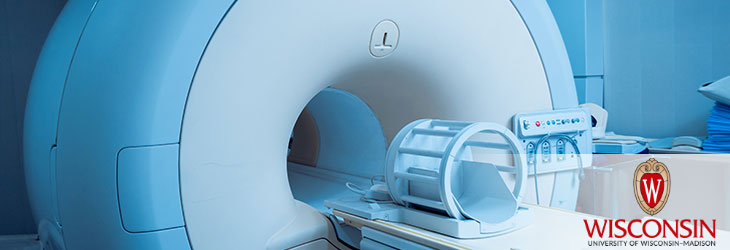Radiation Therapy

Radiation Therapy Modulation by Virtual Analysis to Improve Cancer Treatment in Moving Tissues
WARF: P07181US
Inventors: Wolfgang Tome, Eric Ehler, Karl Bzdusek
The Wisconsin Alumni Research Foundation (WARF) is seeking commercial partners interested in developing an improved method and system for virtual analysis of target tissue motion to modulate radiation therapy used in the treatment of cancer.
Overview
Radiation therapy is a technique used to deliver ionizing radiation to a malignant tumor or other target tissue to control the growth of abnormal cells. If a critical structure such as a tissue sensitive to radiation is near the target tissue, the radiation beams may be configured to avoid the critical structure by changing the angle and intensity of individual beamlets. Intensity modulated radiation therapy (IMRT) is a mature technique for configuring beams by using a modulation device, such as a multileaf collimator, to direct beams at specific angles.
Modulation techniques work well for radiation treatment, but current methods are not as effective when the target area is affected by breathing-induced motion. Cancer prone areas affected by breathing-induced motion include the lungs, stomach, pancreas and liver. When IMRT is used in these areas normal tissues may be exposed to elevated levels of ionizing radiation due to constant motion of the tissue, damaging healthy cells. Gating modulation that controls timed pulses of radiation and dose rate adjustment modulation that controls the amount of radiation emitted per unit time are techniques that may be used to minimize the amount of radiation delivered to normal tissue.
Modulation techniques work well for radiation treatment, but current methods are not as effective when the target area is affected by breathing-induced motion. Cancer prone areas affected by breathing-induced motion include the lungs, stomach, pancreas and liver. When IMRT is used in these areas normal tissues may be exposed to elevated levels of ionizing radiation due to constant motion of the tissue, damaging healthy cells. Gating modulation that controls timed pulses of radiation and dose rate adjustment modulation that controls the amount of radiation emitted per unit time are techniques that may be used to minimize the amount of radiation delivered to normal tissue.
The Invention
UW–Madison researchers have developed an improved method and system comprising a virtual four-dimensional (4-D) treatment suite for developing and evaluating radiation treatment plans. The virtual 4-D treatment suite includes radiation dose calculation, gating and dose rate adjustment modules. The dose calculation module evaluates the effect of motion by predicting the amount of radiation received by the target tissue and determining the possible variation in dose due to motion of the target tissue. The gating module virtually determines the benefits of employing a gating technique by evaluating a gating window set manually or automatically by a practitioner or computer simulated input. The dose rate adjustment module virtually determines the efficacy of dose rate, also by automated computer simulation or practitioner input. The system also may include a collimator angle adjustment module to direct radiation beams and a database to store information about the patient, treatment plans, breathing information or other treatment data.
The 4-D suite also can recognize large variations in delivered dose and alter particular segments of an IMRT treatment session by lowering dose rates. This process, termed selective dose rate modulation, decreases temporal variations in delivered dose while minimally increasing treatment time. The same can be achieved with gating; however, this process leads to a significant increase in treatment time. Selective dose rate modulation is an advantageous technique because it can be applied to radiation therapy procedures that cannot be gated such as volumetric modulated arc therapy (VMAT) and RapidArc, in which dose rate can be altered as a function of gantry angle.
The 4-D treatment suite improves upon previous techniques of developing and evaluating radiation treatment plans by calculating the expected therapy dose and temporal variation in the expected therapy dose. Utilization of these key parameters reduces treatment time with dose rate modulation and decreases radiation of normal cells with gating and beam angle adjustment modules, making radiation therapy a safer and more effective cancer treatment.
The 4-D suite also can recognize large variations in delivered dose and alter particular segments of an IMRT treatment session by lowering dose rates. This process, termed selective dose rate modulation, decreases temporal variations in delivered dose while minimally increasing treatment time. The same can be achieved with gating; however, this process leads to a significant increase in treatment time. Selective dose rate modulation is an advantageous technique because it can be applied to radiation therapy procedures that cannot be gated such as volumetric modulated arc therapy (VMAT) and RapidArc, in which dose rate can be altered as a function of gantry angle.
The 4-D treatment suite improves upon previous techniques of developing and evaluating radiation treatment plans by calculating the expected therapy dose and temporal variation in the expected therapy dose. Utilization of these key parameters reduces treatment time with dose rate modulation and decreases radiation of normal cells with gating and beam angle adjustment modules, making radiation therapy a safer and more effective cancer treatment.
Applications
- Develop radiation therapy treatment plans
- Evaluate radiation therapy treatment plans
- Treat malignant tumors in areas affected by breathing-induced motion such as the lungs, liver, stomach or pancreas
Key Benefits
- Controls dose rate
- Controls gating
- Controls radiation beam angle
- Stores patient treatment data
- Utilizes practitioner and computer simulated inputs
- Allows comparison of multiple treatment plans due to use of virtual analysis
- Reduces treatment time
Stage of Development
Simulation of the dose rate optimizer has been carried out.
For current licensing status, please contact Jeanine Burmania at [javascript protected email address] or 608-960-9846